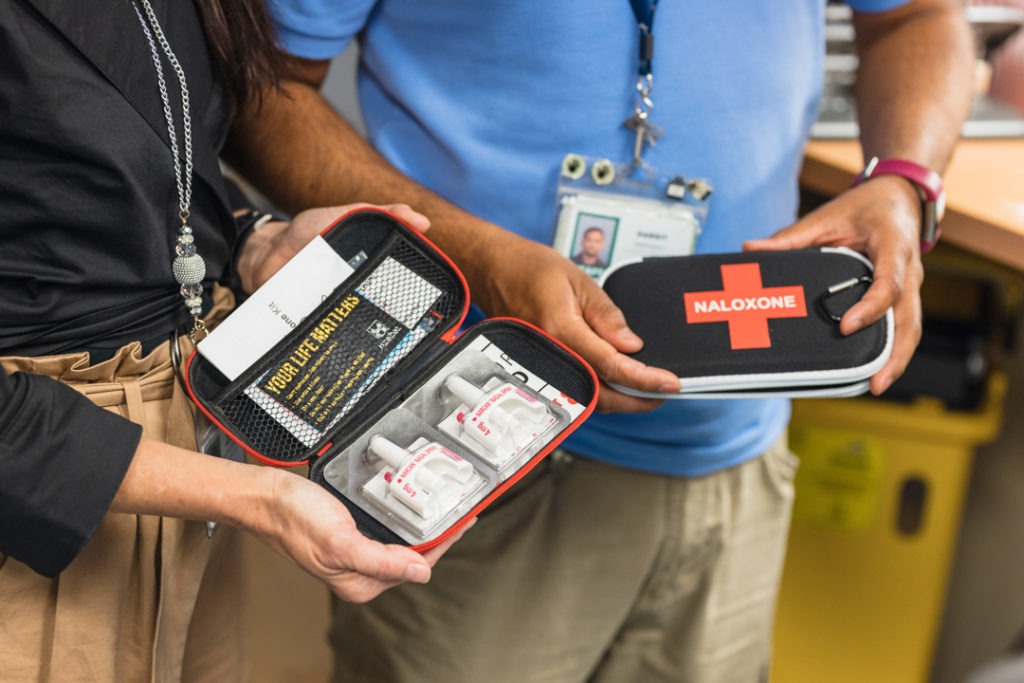
How to use a naloxone kit
By Harsit Patel, clinical pharmacist in the emergency department
Opioid overdosing is the third leading cause of death in Ontario.
In Hamilton, there has been an increase in emergency department visits and deaths due to opioid overdoses since 2016. Learn what to look out for and how to help if you suspect someone is having an overdose.
Signs of an overdose
When someone overdoses, their breathing slows down or stops completely. Signs of an overdose include not being able to stay awake, walk, talk, or breathe. The person may be vomiting, make snoring or gurgling sounds, have a limp body, cold and clammy skin, purple or blue lips and fingertips, and/or tiny pupils. If you suspect someone has overdosed, call 9-1-1 immediately.
Naloxone kits can save lives
Naloxone kits are portable pouches containing an opioid antidote that can be administered by injection or through the nose to revive an unresponsive person who is overdosing. The kits include enough medicine to reverse opioid overdoses for 10-15 minutes, allowing time to access emergency services. Naloxone is only effective for opioids (such as fentanyl, heroin and oxycodone) but not non-opioid drugs (such as cocaine, crystal meth, and MDMA). If you are not sure what the person has taken, you should give naloxone anyway if they are showing signs of an overdose. It is a safe medication that will not cause more harm, even if non-opioids have been used.
Prescription medications can be a risk
An overdose doesn’t only happen from recreational drug use. Patients who are prescribed opioids by their doctors to manage chronic pain are also at risk of accidental overdosing. Patients, and even more so, their family members and friends, are encouraged to learn how to use naloxone kits and have one on hand.
What to do if you suspect an overdose
There are two types of kits: an injectable naloxone kit and a nasal spray naloxone kit – each comes with their own supplies. Each kit also contains education material and contact information that could help prevent future overdoses. If you suspect someone is having an overdose, follow these steps:
1. Shout their name and shake their shoulders. If they are unresponsive, call 9-1-1.
2. Give naloxone (1 spray into nostril or inject 1 vial into arm or leg). Opioids last longer than the naloxone, so it’s very important to seek medical attention, even when naloxone is given and symptoms improve.
If using the spray: Lay the person on their back. Support their neck and tilt their head back. Peel back the package and remove the device. Place the tip of the nozzle in one nostril. Press the plunger firmly to release naloxone into the person’s nose.
If using the injection: Tap the ampoule (the vial containing the medicine) to send all the liquid to the bottom. Snap open the ampoule by breaking off the top. Using the syringe and needle included in the kit, pull the plunger to draw up the liquid. Inject it into muscle in the upper arm or upper thigh. Press the plunger all the way down.
3. Give 30 chest compressions and two rescue breaths (if you are comfortable doing so).
4. If there is no improvement after 2-3 minutes, repeat steps 2 and 3. Stay with the person.
5. If the person begins breathing on their own, or you have to leave them alone, put them in the recovery position. Roll them on their side with their head tilted back slightly to open the airway. Their hand supports their head and their knee stops the body from rolling onto their stomach. Monitor them, as they may be confused, upset or going into withdrawal when revived. Do not allow them to use more drugs.

Recovery position
Overdose Myths
| Do Not | Reason |
| Put the person in a cold bath. | They may drown or go into shock. |
| Make the person vomit. | They may choke. |
| Inject the person with something else (i.e. salt water, cocaine, milk). | They may be seriously harmed. Only naloxone can reverse the overdose. |
| Slap, hit, kick or try to hurt the person. | They may be seriously harmed. You cannot wake them up with pain. |
| Let the person sleep it off. | They may stop breathing and die. |
Kits are available for free
Naloxone kits are available for free at any community pharmacy, including the outpatient pharmacies at Hamilton Health Sciences and Hamilton Public Health clinics. If carried at the right place and the right time, these kits can save lives. So far this year, over 10,000 kits have been distributed in Hamilton. Last year, naloxone kits revived over 2,000 people in the community.
Opioid dependence threatens the lives of many people every day. Naloxone is a safe and effective way to rescue people, allowing more time to access emergency services and affording the opportunity to access community resources to help people to move to rehabilitation and recovery.
Resources:
Fight the Crisis
Alcohol and drug Addiction Assessment and Treatment – Hamilton Niagara Haldimand and Brant Resources
